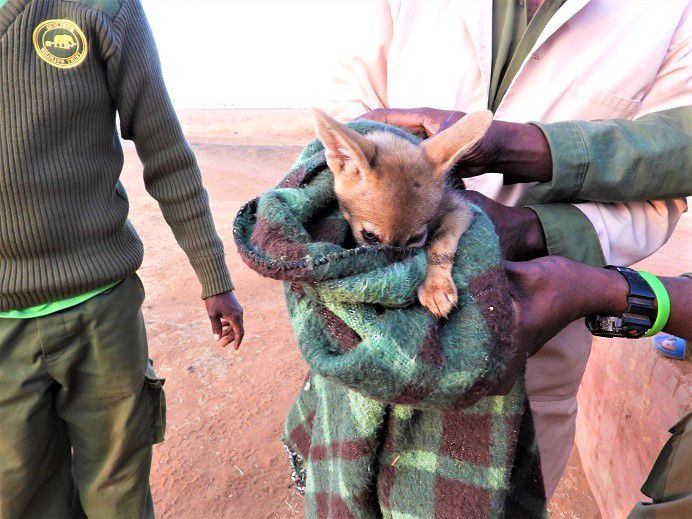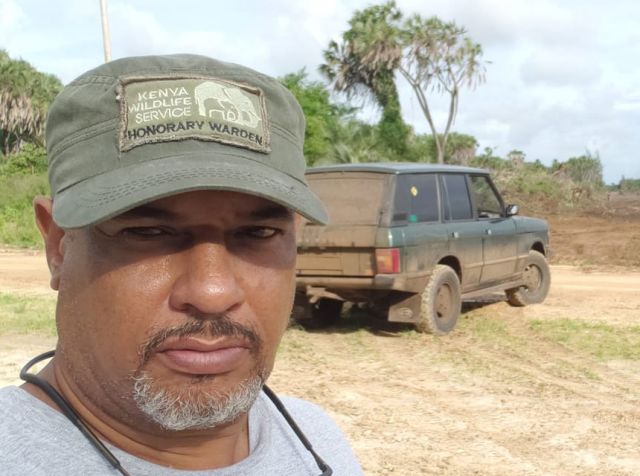
WILDLIFE
22-07-2021 by Giovanna Grampa

It is so rare for us to have exciting experiences in these difficult times when our daily lives are almost exclusively filled with single-issue news about vaccines, green passes and ever-changing covid variants. And yet, once again, the Tsavo East savannah has provided us with new emotions, giving us the opportunity to rescue a silver-backed jackal cub stuck in a concrete pipe from which it would never have emerged without our help.
Special stories, waiting for the return to normality, that give you the awareness of still living inside the enchanted fairy tale that only Africa can give you.
The jackal is certainly an animal little loved by humans, who see it as a malevolent and exploitative predator. In ancient times it was deified in Egypt and depicted on the paintings of the pharaohs' tombs as a guide for the souls of the dead. Although it is unfairly considered unpleasant, everyone agrees that it plays an essential role in the ecological balance of the savannah: by cleaning up the carcasses of dead animals, it prevents the spread of many diseases in African fauna.
The jackal is a medium-sized canid and is distinguished from other species by a sort of grey coat with silvery highlights that borders its tawny flanks. With its thick tail, long, firmly planted paws and pointed ears, it looks like a small, non-aggressive domestic dog and is often shy and elusive.
I love photographing them and watching their fast and nervous pace, always on the lookout for food, in pairs or in groups: they are animals that inspire sympathy in me and have enriched my diary of savannah stories.
Only a few days have passed since our rescue, but the memory is still intense with emotions that I relive as clearly as if they had just happened.
As we walk through an area of the park called "Pipeline" we notice, late in the afternoon, three jackals moving strangely agitated around a low concrete building painted a worn pink. The area owes its name to the construction of an underground pipeline that, starting in the 1950s, provided a constant supply of water to the then booming city of Mombasa. It runs from its source at Mzima Springs in Tsavo West and crosses over 40 km through Tsavo East Park. The line was built with reinforced concrete pipes and over the years has triggered many leaks that have required significant repairs. The concrete posts, containing valves and inspection hatches spread along the route, are partly dilapidated with old pipes and abandoned debris scattered all over the place.
All around is a plain as far as the eye can see, stretching as far as the hills of Voi, where the sun makes the rusty reds of the earth even more beautiful, trampled by herds of zebras, kongons, gazelles and groups of elephants that appear suddenly to drink from rivulets of water, generated by leaking pipes, and then disappear silently in clouds of reddish dust. An immense and boundless sky lends grandeur to everything it covers, giving this wild place an uncontrollable beauty.
We observe the jackals zigzagging around one of these concrete structures and as I take the picture I notice that one of the three jackals, a female, is moving away from the group and trying to get into a pipe, hidden from our view, which protrudes from the structure by a few tens of centimetres. She enters almost with her whole body, pointing well on her hind legs, but withdraws shortly afterwards, looking around anxiously and worriedly.
The wind has been blowing with strong gusts since the morning and it's like a rough caress that never stops, but I'm sure I can hear unmistakable sounds coming from that very tube, similar to the faint yelp of a puppy.
Jackals have several burrows that change as their young grow, especially if they are disturbed by predators. It is easy to assume that pups were hiding in that tube. We change our point of observation in the hope of photographing the well-hidden offspring because there are very few images of these shy animals, almost always hidden in isolated dens that are difficult to spot. Having moved the camera into a favourable position, we are amazed.
The hole, which is almost level with the ground, is completely open and leads into a small, narrow valve inspection room, more than two metres deep. At the bottom are a few galana stones and another hole, which presupposes a cylindrical connecting pipe.
In the meantime, the female observes us sitting in the dry grass, turning her head towards us, perhaps in search of help, ears outstretched and eyes fixed on our movements. The silence is now broken by the insistent yelp of a panic-stricken puppy, who is constantly shrieking in alarm and terror in a shrill voice, a yelp of hysterical pain that makes your skin crawl. Inexplicably, he ended up in the very pipe that can be seen at the bottom, after a thud of a couple of metres. The mother would never have been able to reach him again and the baby's fate would have been tragically sealed.
Since we had nothing with us to recover the poor cub, we asked David Sheldrick, the specialist animal rescue team, for help. Thanks to a rusty iron ladder, fixed with bolts to the wall of the inspection room, two men climbed down with difficulty to the bottom with a lamp and a blanket: making light they assured us that the puppy was frightened but lively while with one arm, wrapped in the blanket, they entered the pipe to surround the little one who in the meantime had stopped screaming. It is fundamental not to touch the animal with the hands in order not to leave the human smell on its fur, respecting its wild state: the mother could even refuse it and abandon it.
With extreme delicacy, it is brought back to the surface and, although exhausted and frightened, it begins to scamper frantically to get out of its woolly shell.
He is uncontrollable and we only manage to take a few quick photos of his splendid little downy face with pointed ears and the intense gaze of a strong-willed puppy.
The mother, who has been following the whole scene from afar, comes closer with a watchful eye while the cub, who has been put down, runs with impressive speed, full of energy despite the misadventure, to his real den dug in the ground not far from us, reaching his little brothers who have been waiting for him for who knows how long.
The following morning we return to Pipeline for a further check and find the young mother sitting at the entrance to her den, calm and relaxed, waiting for her father to return with some small prey to feed her offspring. She looks at us with her sharp little foxy face, her eyes shining as if she wanted to thank us: the cubs are the biggest investment in the existence of a living being and their survival ensures the survival of a species, generation after generation.
I would only advise the young mother to move her cubs to a safer den.
Right on top of those concrete structures I have very often photographed, at sunset, beautiful lions sitting and relaxing, gazing at the numerous herbivores that crowd the Pipeline, waiting to choose their evening meal: a decidedly unsuitable place to raise a happy litter of young and restless jackals.
EVENTS
by redazione

A promotion of three months to live all the excitement of the savannah, from Malindi, Watamu and Mambrui.
The idea of ​​Malindikenya.net which is part of our initiatives to boost tourism, has found the happy Osteria Swara Camp partnership, which...
NEWS
by redazione

The sadness is deep for fans of the savannah that after so many safari, had learned to recognize it.
Satao II, one of the few remaining elephants by the giant tusks in Kenya, the "big tuskers" (estimated there would be no...
ENVIRONMENT
by redazione

The efforts made so far to ensure water to Tsavo National Park and its ecosystem may not be enough.
The closest savannah to the Kenya coast threatens to extinction in 15 years unless seriously created irrigation systems and new dams.
NEWS
by redazione

From today, the Buffalo Camp, lodge just outside of Tsavo East National Park, has a new owner.
The Osteria Group Maurizio Corti won the tender auction which granted the concession of the Government to manage and organize the safari camp. The...
WILDLIFE
by Leni Frau

He was one of Tsavo's "Super Tuskers." Lugard, an iconic elephant with huge tusks and regal bearing, also...
MOURNING
by Freddie del Curatolo

A tragic fate united him with his Italian father Vittorio, who lost his life 40 years ago in a plane...